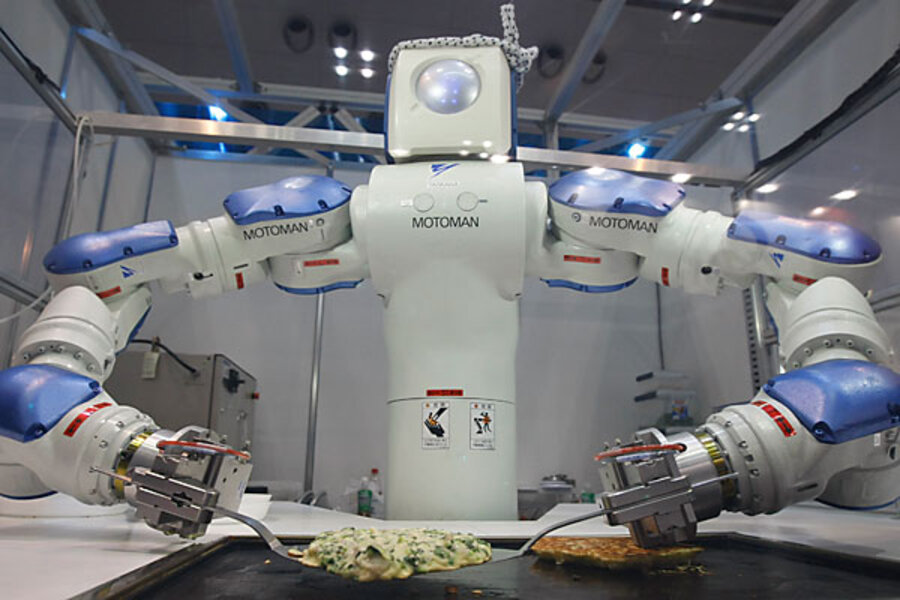Japan’s robot revolution moves from factory to the home
Loading...
| Tokyo
It looks a little like C-3PO from the “Stars Wars” movies, minus the gold sheen and the attitude. Robovie-II, a Japanese robot with swinging arms and an inquisitive demeanor, has strolled the halls of an Osaka mall to help customers shop.
It could detect people who were walking aimlessly and steer them toward their destination. A more recent version of the robot has helped the
elderly buy goods at a supermarket.
The arrival of the android shopping assistant, even though still experimental, is a reminder that the robot revolution in Japan is increasingly moving from the factory floor to the home, the hospital, the local restaurant, and even the rice paddy.
Long a leader in industrial robotics – Japan is home to almost half the world’s 800,000 factory robots – the country is now pioneering uses of automated help for the consumer. Along the way, it is redefining the relationship between man and machine. Already, the country has robots that clean, pour drinks, function as security guards, play pool, dance, care for the elderly, act as pets and companions, serve sushi – everything but write this story (a-s f-a-r a-s I k-n-o-w).
“We see robots as media just like a mobile phone,” says Norihiro Hagita, director at ATR Intelligent Robotics and Communication Laboratories in Kyoto. “And just like a mobile phone, robots would be indispensable in future.”
Several factors are driving Japan’s thrust into consumer robotics. One is the country’s savvy with technology. But a bigger reason is demographics. As the country’s population ages, robots are considered one solution to a shrinking workforce.
Take the healthcare industry alone. In the near future, the government health and welfare ministry estimates that the country will need as many as 50,000 more healthcare workers a year. This is one reason Toyo Riki Co. Ltd., an Osaka-based company that has designed industrial robots for nearly a half century, began making communication robots a few years ago.
It has one machine that helps patients with physical rehabilitation. Another welcomes visitors as a “guard” at a hospital entrance. “We want robots to master [or learn] craftsmen’s skills, as very few young people are willing to do so,” says Narito Hosomi, president of Toyo Riki.
Other companies are developing “partner” robots that will act as companions to the elderly, carrying on simple dialogue. Secom, a security- service company, manufactures a robot called “My Spoon” that helps handicapped people eat a meal.
In other cases, robots are being developed to perform dirty and dangerous tasks. One machine helps fight fires. At the National Agricultural Research Center in Tsukuba, northeast of Tokyo, researchers are working on a robot that plants seeds in rice paddies. It combines a GPS guidance system with an automated harvester. “In many cases, robots certainly are produced to do what many people don’t want to,” says Katsuhiko Tamaki, a senior researcher on the project.
Still, devising robots for uncontrolled environments, ones that operate outside a factory, isn’t easy – or cheap. The autonomous rice planter,
for instance, has come down from its original price tag of $200,000 a decade ago. But it still costs $90,000.
More recently, the Japanese have been touting robots for use in the kitchen. At recent expos, Toyo Riki showcased a robo-chef, spatula in hand, that flipped pancakes. Other robots served sushi and sliced vegetables. Researchers envision them handling repetitive jobs in restaurants and in homes.
Japan is “doing a great job on manipulation and hardware – the ability to make robots do what you want to do,” says Curt Stone, an expert at Carnegie Mellon University in Pittsburgh.
All of which underscores one other point about the Japanese: Unlike the US, which has focused much of its attention on developing advanced robotics for use in industry and the military – and which has often viewed them as a threat to jobs – the Japanese embrace them with an almost spiritual reverence. Last month, a robot exhibition in Tokyo drew 100,000 visitors.
“Many Japanese people got familiar with manga characters in their childhood,” says Mr. Hosomi, referring in particular to the famous Japanese cartoon Astro Boy, about a youthful robot with a big heart. “I think that contributes a sense of affinity to robots. Some people even ask me, ‘Have you produced an Astro Boy yet?’ ”





